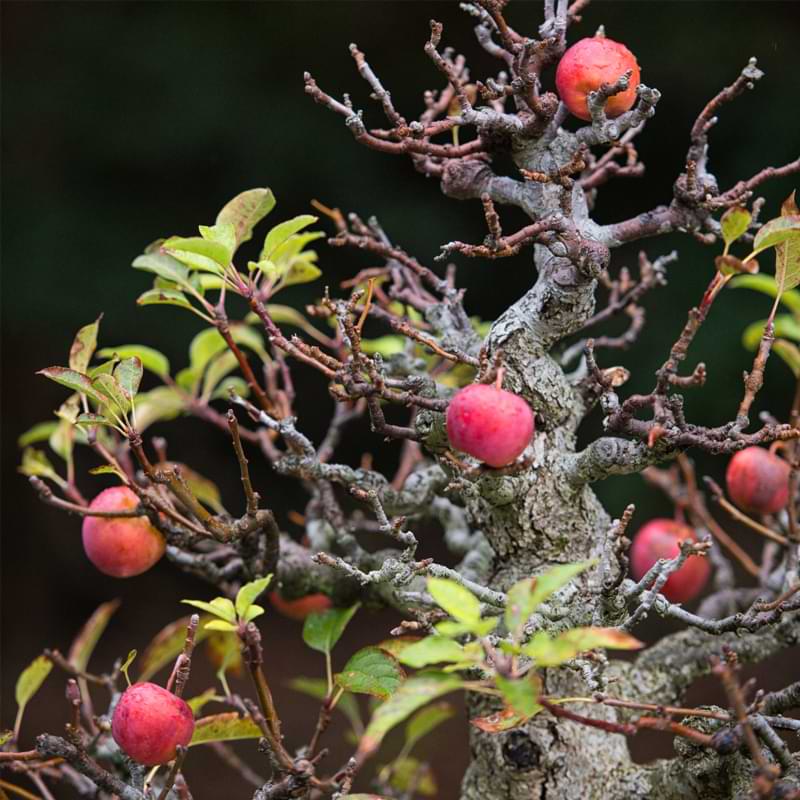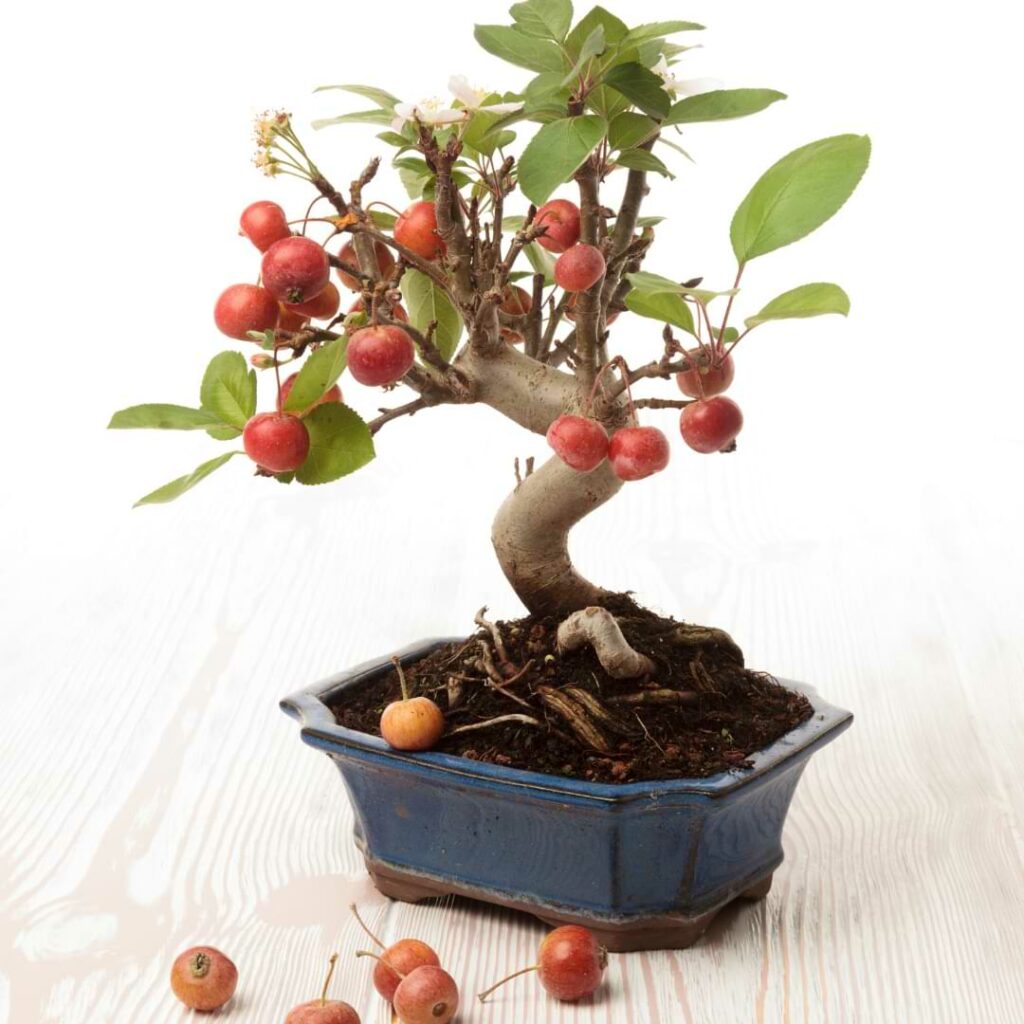Bonsai apple trees are a unique and beautiful addition to any home or garden. Not only do they offer an interesting aesthetic, but they can open the door to a new hobby that you may have never thought about before. Keep reading to discover how to care for a bonsai apple tree, and why this tree is an amazing choice to bonsai!
Why Apple Trees Make A Good Bonsai
Bonsai apple trees are a popular choice for bonsai enthusiasts because they have a beautiful weeping habit that makes them ideal for growing in the limited space of a bonsai pot.
Apple trees are also relatively easy to care for, and can be trained to produce an impressive display of fruits and flowers. They do require more care than a regular sized fruit tree or a regular bonsai tree that does not fruit, but they still are not too difficult to care for. With proper care, a bonsai apple tree can live for many years and provide its owner with years of enjoyment.

Bonsai Apple Tree Care
Taking care of a bonsai apple tree isn’t as difficult as you may think. While it is a bit more complicated to care for than a regular fruit tree or even a bonsai tree that does not fruit, it is still relatively easy to care for. Just get some basics taken care of at first, and then all you have to worry about is regular bonsai tree maintenance!
Soil
Bonsai apple trees need well-draining soil that is high in organic matter. A good potting mix for bonsai apple trees is a mixture of two parts loam, one part peat moss, and one part sand. The soil should be lightly moistened before planting. Bonsai apple trees are susceptible to root rot, so it is important to make sure the soil drains well.
You can either make your own potting mix for your bonsai tree, or choose a premade bonsai tree potting mix that has the perfect mixture for all bonsai varieties.
Position & Temperature
To ensure your bonsai apple tree grows healthy and strong, it’s important to give it a good place to grow either in your home or outside. The ideal position for your bonsai apple tree is in an area that receives full sun for at least six hours per day. If you live in a climate with very hot summers, you may want to give your bonsai apple tree some afternoon shade to protect it from the harsh sun. If you are growing your bonsai tree inside, you may need to place a grow light close to your tree to ensure it gets enough light if you don’t have a window that will give it as much sunlight as it needs.
When it comes to temperature, your bonsai apple tree should be fine in temperatures as low as 50 degrees Fahrenheit. However, if the temperatures dip below freezing, you’ll need to take measures to protect your tree, such as bringing it indoors or covering it with a frost blanket. Your tree should do okay with warmer temperatures, but if it’s a relatively new tree, you will want to protect it from temperatures above 90 degrees.
Indoor or Outdoor Growing
It really doesn’t matter if you grow your bonsai apple tree indoors or outdoors. However, there are a few things to consider when making your decision. If you live in an area with a harsh climate, it’s best to grow your bonsai apple tree indoors, or at least bring it inside during the harsher weather months. This will protect it from the elements and help it to thrive.
If you live in a more moderate climate, you can choose to grow your bonsai apple tree either indoors or outdoors. Just be sure to provide it with plenty of sunlight and water, no matter where you decide to grow it.
Water
Water is critical for the health of your bonsai apple tree. During the growing season, water your tree deeply and regularly to encourage deep roots. Allow the soil to dry out between waterings. In winter, reduce watering to once per month.
Your bonsai apple tree will need more water when it is actively growing in spring and summer. Water at the roots to avoid getting the leaves wet. This will prevent any type of fungus or disease from growing on the leaves, and will ensure the leaves don’t get burn spots when the sun hits the water drops.

Fertilizing
When it comes to feeding your bonsai apple tree, less is more. This is because bonsai trees are planted in small pots, which means that the roots can’t spread out to search for food and water like they would in the wild. For this reason, you should only fertilize your bonsai apple tree every two weeks or so during the growing season (spring and summer), using a diluted liquid fertilizer such as fish emulsion. Be sure to follow the instructions on the fertilizer package, as too much fertilizer can damage your tree.
Fruit
The fruit from your bonsai apple tree is actually edible! Be careful when taking fruit off of the branches; you don’t want to accidentally snap a branch. They will grow regular sized fruit, so make sure you have a pot that will keep your plant balanced even with full sized apples hanging off of it.
The best apple tree varieties to use as a bonsai tree are cherry apple, coral apple, Japanese mountain apple, and crab apple. They are a naturally smaller variety of apple trees, and are perfect as a bonsai tree that will give you delicious fruit.
Re Potting
Every plant eventually needs to be repotted, and bonsai trees are no different. If you are bringing an already grown bonsai tree home, then you may not need to repot it, but should any root issues come up, you will have to. When growing a bonsai tree from seed, you will need to repot your tree from the seed starting medium you used to sprout it. Repotting is a simple process, just follow the steps below and your plant will be happily growing in its new pot in no time.
- Choose a pot that’s just big enough to fit the roots of your bonsai apple tree. It should have drainage holes in the bottom and be deep enough so that the roots can spread out.
- Add some well-draining bonsai potting mix to the bottom of the pot.
- Gently remove your bonsai apple tree from its current pot and shake off any excess soil. Use this time to inspect the roots for any possible damage. Prune off any rotted roots if you see them.
- Place the tree in the new pot and fill in around the roots with more potting mix. Firm it down gently with your hands.
- Water the tree well and place it in a sunny spot. Avoid fertilizing your tree for a few weeks to allow it time to adjust to its new home.
Apple Tree Bonsai Shaping And Maintenance
Shaping your bonsai apple tree will give it that iconic bonsai tree shape. You could leave it to grow however it wants to, but part of the appeal of having a bonsai tree is shaping it in certain ways. To shape and maintain your tree, you’ll first need a good set of pruning shears and some bonsai tree wire.
First, you will need to know how to prune your tree without hurting it, and then you can begin training your tree to grow the way you want it to.
Pruning
Pruning is an important part of caring for a bonsai apple tree. It helps to keep the tree healthy and promotes new growth. When pruning, be sure to remove any dead or damaged branches. Cut back any branches that are growing too long or out of shape.
As a general rule, prune in late winter or early spring before the tree begins to bud. This will help ensure that the cuts heal quickly and encourage new growth.
Training
When training your bonsai apple tree, the sky’s the limit! There are a variety of techniques you can use to shape and train your tree into the beautiful work of art you envision.
One popular training technique is called “wiring.” This involves wrapping thin gauge aluminum or copper wire around the branches of your tree in order to bend and shape them into the desired position. Wiring takes time and patience, but the results can be stunning.
Another option is just pruning to the shape you want. This involves carefully trimming away excess leaves, branches, and roots in order to encourage new growth in the desired direction. Pruning can be used to create a more compact and dwarf-like appearance, or to encourage branch growth in a particular direction.
Whatever training technique you choose, be sure to do your research and proceed with caution. Improper training can damage your tree beyond repair, so it’s important to take things slowly and be gentle with your bonsai apple tree. With time and patience, you’ll be able to create a true masterpiece!
Wiring
In order to ensure that your bonsai apple tree grows properly, you will need to wire it correctly. This process involves wrapping thin wires around the trunk and branches of the tree in order to shape it how you want.
If you are new to bonsai wiring, it is best to start with the trunk first. You will want to wrap the wire around the trunk in a spiral pattern, starting from the bottom and working your way up. Once you reach the top of the trunk, you can then begin wiring the branches.
When wiring branches, it is important to be careful not to damage the bark. You will also want to make sure that the wire is tight enough so that the branch does not move too much, but not so tight that it cuts into the bark.
Once you have wired all of the branches, you can then begin shaping them how you want. This includes bending and twisting them into different positions. It is important to be careful when doing this so that you do not break or damage any of the branches.
Once you are satisfied with the shape of your bonsai apple tree, you will need to leave the wires on for at least a few months, until the sections that are wired can stay in that position by themselves. Once the branches stay where you want them, you can then remove the wires and enjoy your beautiful creation!
It’s important to note that when removing the wire, you’ll want to snip the wire off as opposed to trying to unravel the wire. There’s a higher chance of injuring your tree if you try to take the wire off without cutting it. Just be careful not to snip into the side of your tree.
You should also remove the wire if you see that the branch or trunk is growing into the wire. This can cause a lot of damage to your tree and will look unsightly if the tree calluses over the wire. If the branch won’t stay in the position you want it to after removing the wire, you can always rewire the same section again, keeping just enough space to allow the branch to grow thicker.
Bonsai Apple Tree FAQ
How long does it take to grow a bonsai apple tree?
It takes between three and five years for a bonsai apple tree to reach its full potential size. However, this time frame can be shortened or lengthened depending on the level of care and attention given to the tree.
Can you eat fruit from a bonsai tree?
You can eat fruit from a bonsai tree, but you need to be careful not to damage the tree. The best way to eat fruit from a bonsai tree is to pick it when it is ripe and then eat it immediately. If you leave the fruit on the tree for too long, it will start to rot and attract pests.
Final Thoughts: Bonsai Apple Tree Care
As with any bonsai tree, the key to keeping your bonsai apple tree healthy is proper care. Water your tree regularly, making sure the soil stays moist but not soggy. fertilize your tree every two weeks during the growing season with a balanced fertilizer. Keep an eye out for pests and diseases, and treat accordingly if you see any problems.
In addition to regular care, you’ll need to shape your bonsai apple tree periodically if you want it to have a traditional bonsai tree look. Trim back new growth to keep the desired shape of your tree. You can also prune branches and roots as needed to keep your tree healthy and in balance.
With proper care, your bonsai apple tree will thrive for many years. Enjoy watching it grow and change over time, and enjoy the unique fruit it produces.
Bonsai With Us!
The Bonsai Resource Center is here to help you learn the best bonsai tree care and provide you with the tools you need to keep your tree healthy and strong. Explore our other articles, visit our online shop, and connect with other bonsai lovers in our Facebook group to learn everything you need to know about this rewarding hobby!



